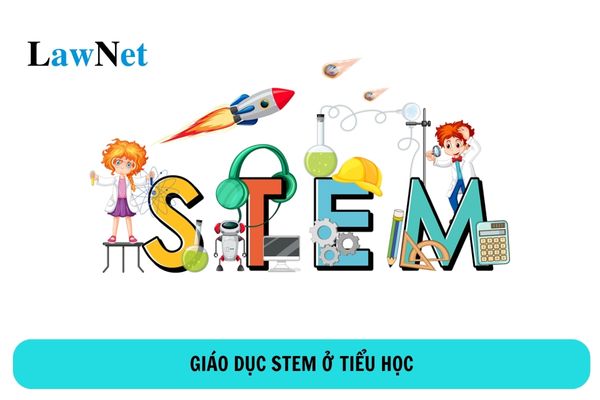What is STEM Education in primary schools in Vietnam? Forms of STEM Education in primary schools in Vietnam?
What is STEM education in primary schools in Vietnam?
According to Subsection 1, Section 2 of Official Dispatch 909/BGDDT-GDTH of 2023 guiding the organization of STEM educational activities in primary education as follows:
II. Content and Forms of Organizing STEM Education
- STEM Education Content
STEM education is primarily an educational method based on integrated learning, creating opportunities for students to mobilize, aggregate knowledge, and skills in the fields of Science, Technology, Engineering, and Mathematics to develop qualities, capabilities, and solve real-life problems effectively.
When implementing STEM education, it is encouraged to integrate elements of art, humanities in some curriculum subjects/activities to broaden and enhance practical education, collaboration in various ways to promote students’ creativity, aesthetics, curiosity, and empathy (implementing STEAM education).
...
Thus, STEM education in primary schools in Vietnam is understood as an educational method primarily based on integrated learning, creating opportunities for students to mobilize, aggregate knowledge, and skills in the four fields to develop qualities, capabilities, and solve real-life problems effectively. The four fields include:
- Science;
- Technology;
- Engineering;
- Mathematics.

What is STEM Education in primary schools in Vietnam? Forms of STEM Education in primary schools in Vietnam? (Internet image)
Forms of STEM Education in primary schools in Vietnam?
According to Subsection 2, Section 2 of Official Dispatch 909/BGDDT-GDTH of 2023, the forms of organizing STEM education in primary schools in Vietnam are guided as follows:
* STEM Lessons
Teaching subjects through STEM lessons is a form of organizing instruction that implements intra-disciplinary or interdisciplinary integration. This is the primary form of STEM education implementation in schools to achieve the effectiveness of the Primary Level General Education Program.
The content and required outcomes of STEM lessons adhere closely to the required outcomes of subjects/educational activities within the Primary Level General Education Program.
The duration for organizing STEM lessons is based on the duration of subjects/educational activities related to the STEM lesson in a scientific, flexible manner, appropriate to the psychological and age characteristics of students, without overloading students and teachers, and presented in the school's educational plan as regulated.
The process of implementing STEM lessons is based on the engineering design process or the scientific discovery process with appropriate learning activities for students and using primary level instructional equipment as regulated by the Ministry of Education and Training (MoET) along with students’ learning materials in subjects/educational activities, easily accessible and available materials for teachers and students.
The use of supplementary digital resources, virtual experiments, simulations, software that can be easily accessed inside and outside the classroom is encouraged to help students take initiative in learning.
Student evaluation in STEM lessons is conducted as per the regulations on assessment according to the Primary Level General Education Program.
Based on the required outcomes of STEM lessons, teachers evaluate students using primary methods such as observation, questioning, evaluation through study portfolios, students' products, activities. In evaluating, special attention is given to process evaluation (continuous assessment) to motivate students' progress, fostering confidence and interest in learning.
* STEM Experiential Activities
STEM experiential activities are organized through STEM clubs, STEM days/events, STEM learning projects, or real-life STEM experiential activities at suitable locations according to students' goals, interests, talents, and desires to create learning enthusiasm and motivation, contributing to the development of students' capabilities, qualities and nurturing passion, talents.
STEM experiential activities are included in the school's educational plan in accordance with the educational institution’s conditions and local realities.
STEM experiential activities are designed based on interdisciplinary integrated teaching, addressing multiple fields requiring students to mobilize and aggregate knowledge, skills to propose solutions for solving real-life problems effectively, flexibly, and creatively.
The space and time for organizing STEM experiential activities can extend beyond the school environment (production facilities, universities, research institutes, etc.) outside the time of subjects/educational activities.
* Introduction to Scientific and Technical Research
Introducing scientific and technical research is a form of organizing STEM educational activities intended for students with talents, interests, initial enthusiasm for exploring, approaching scientific and technical research to solve real-life problems.
Through organizing the teaching of STEM lessons and STEM experiential activities, teachers identify talented students to nurture and provide favorable conditions for them to get acquainted with scientific and technical research.
Educational institutions organize STEM educational activities so that students have the opportunity to get acquainted with scientific and technical research in the form of individual or group research projects guided by one or more teachers, or in cooperation with other relevant social forces related to the research content (such as family, production facilities, universities, research institutes, science centers, experts, artisans, scientists, etc.).
Based on practical conditions, educational institutions may organize STEM experiential activities, science and technology research interaction days/events as a basis to select research projects to participate in science and technology research playgrounds suitable for primary school students.
3 Objectives and requirements for STEM Education activities in primary schools in Vietnam?
According to Section 1 of Official Dispatch 909/BGDDT-GDTH of 2023, STEM education in primary schools in Vietnam has the following objectives and requirements:
- Raise awareness for management staff and teachers about the position, role, and significance of STEM education in implementing the Primary Level General Education Program; unify the content, methods, and forms of organizing STEM educational activities; foster and enhance management and organizational capacities for STEM educational activities for teachers in primary education institutions.
- Effectively implement STEM educational activities to support and enhance the education of Science, Technology, Engineering, Mathematics, Informatics, and Arts; create interest, spark passion for learning, help students explore personal potential, scientific and technological discoveries, promote positive creativity and application to solve problems in specific real-life contexts.
- Organize STEM educational activities following the objectives, required outcomes of related subjects/educational activities, in line with students’ psychological characteristics, cognitive development levels, and school conditions; promote integrated teaching organization, without causing pressure or overload for students and teachers.

